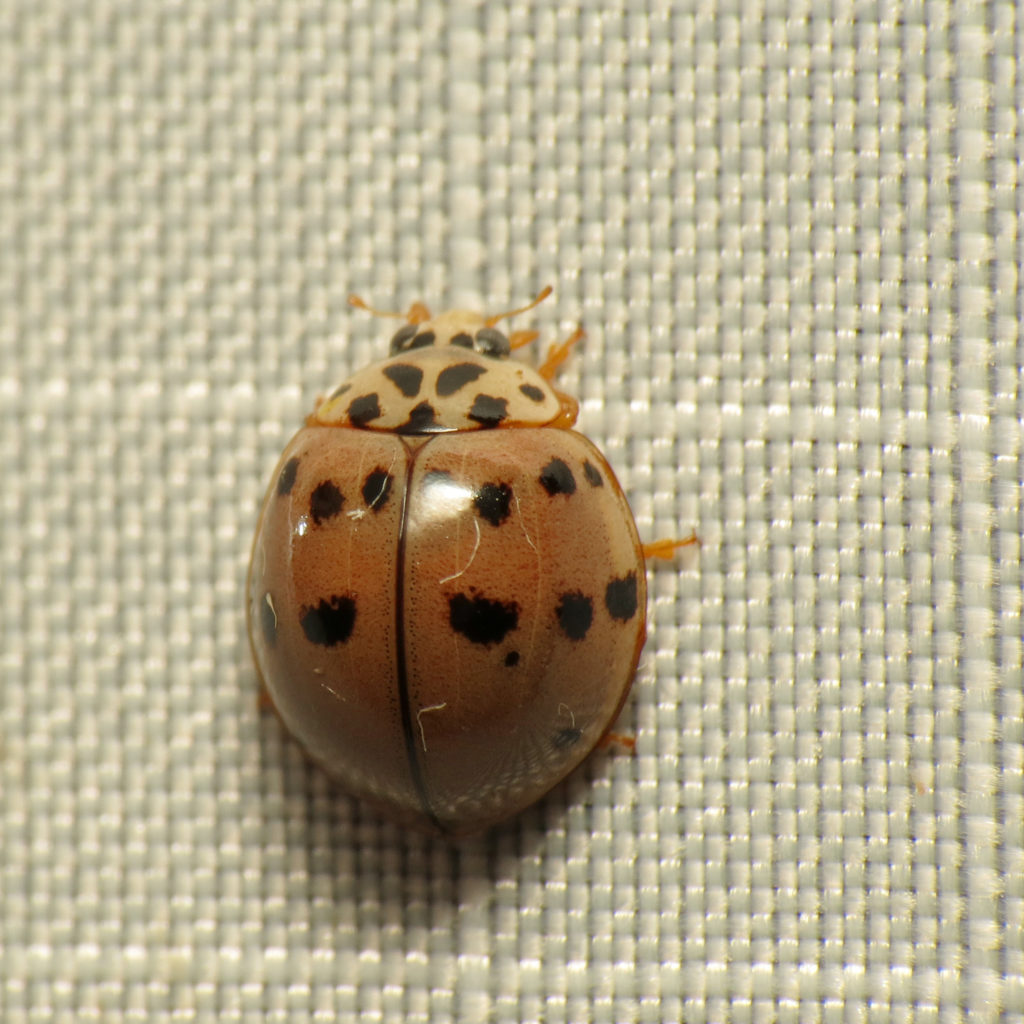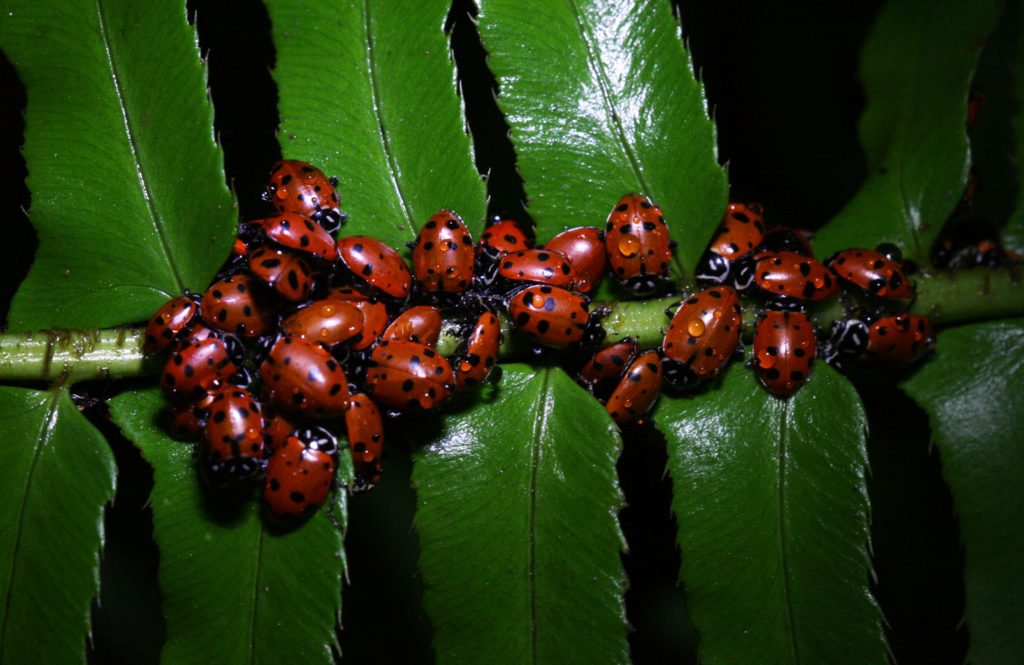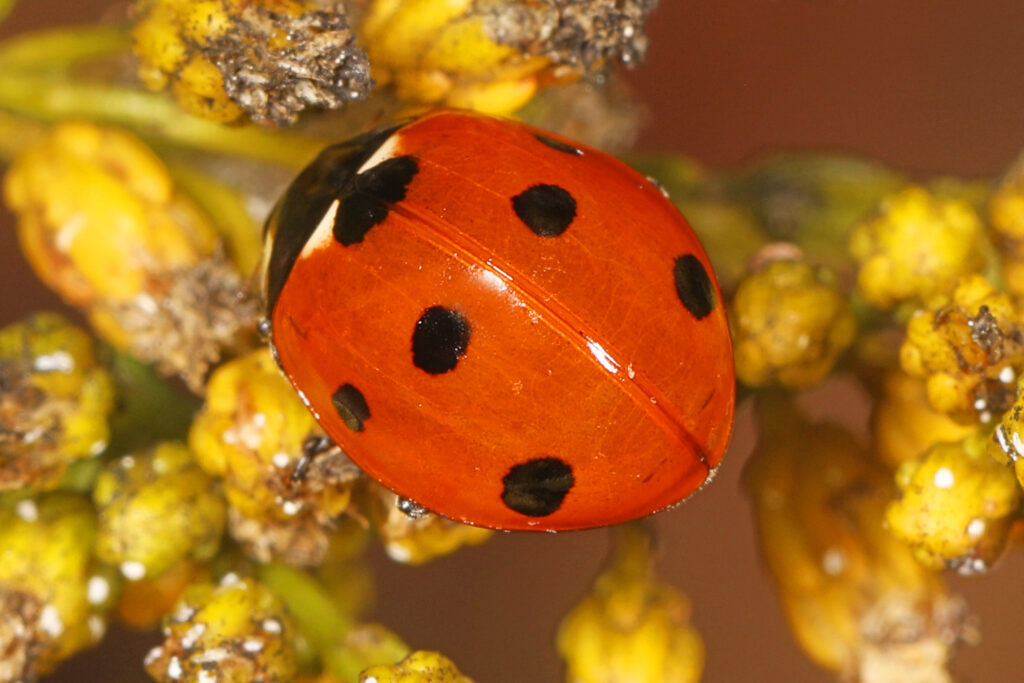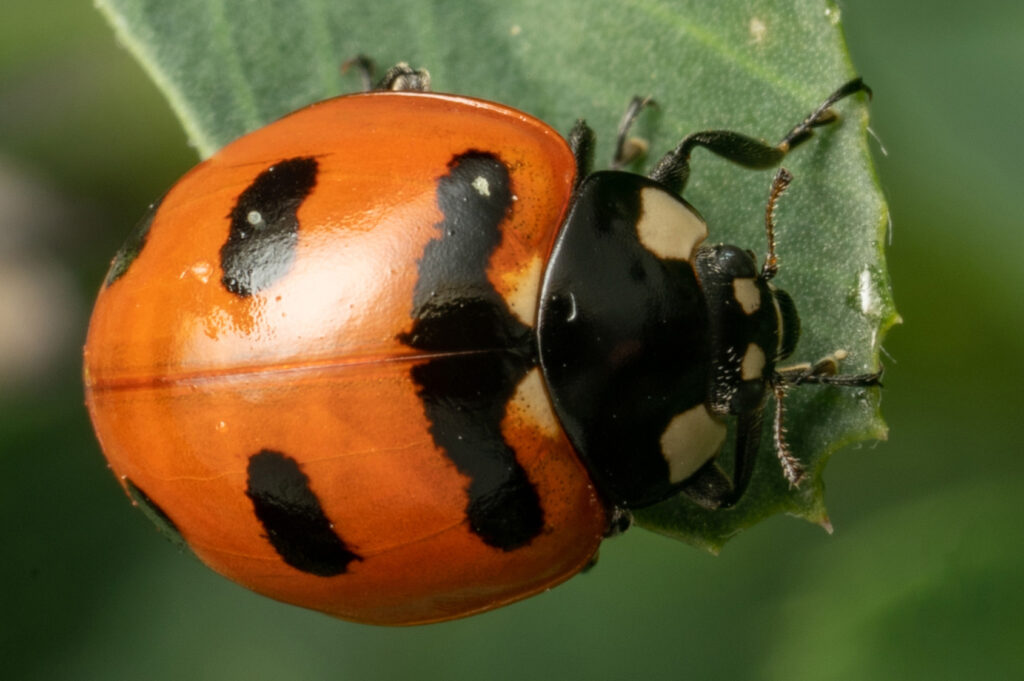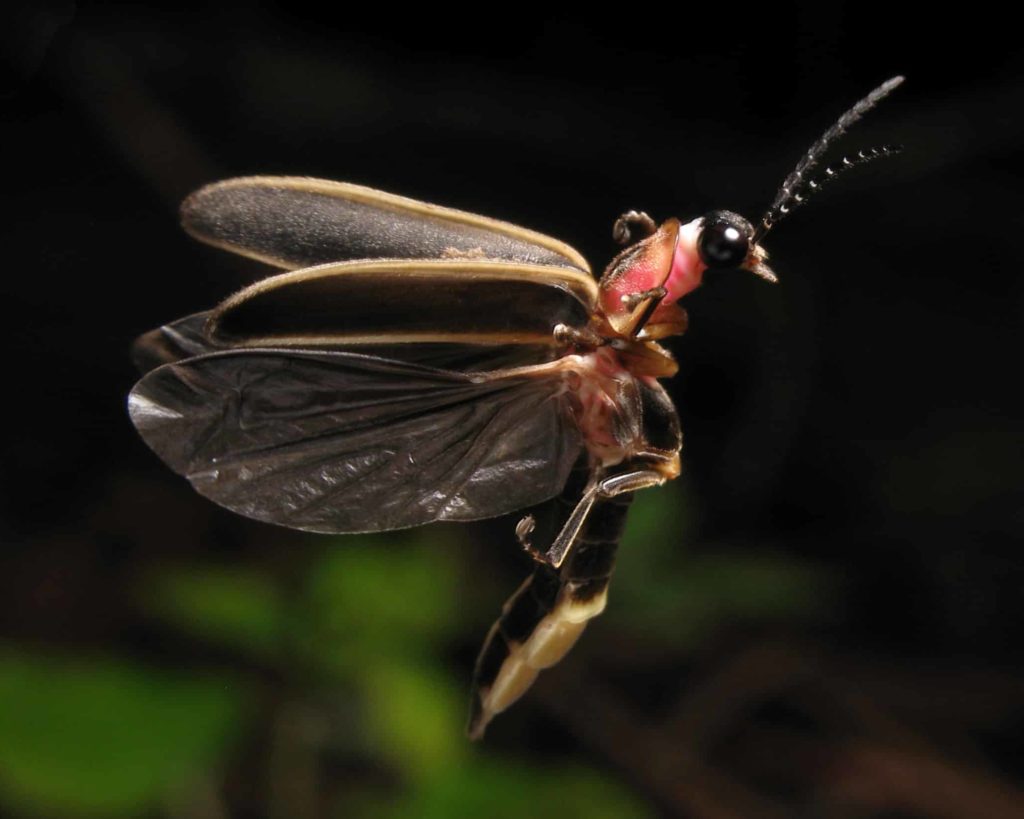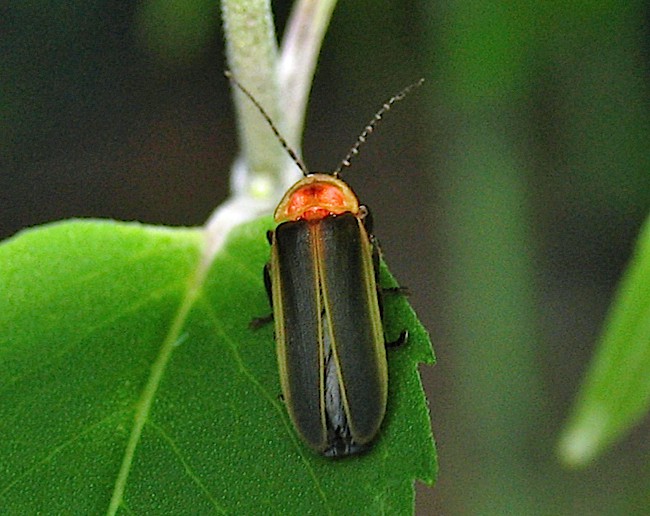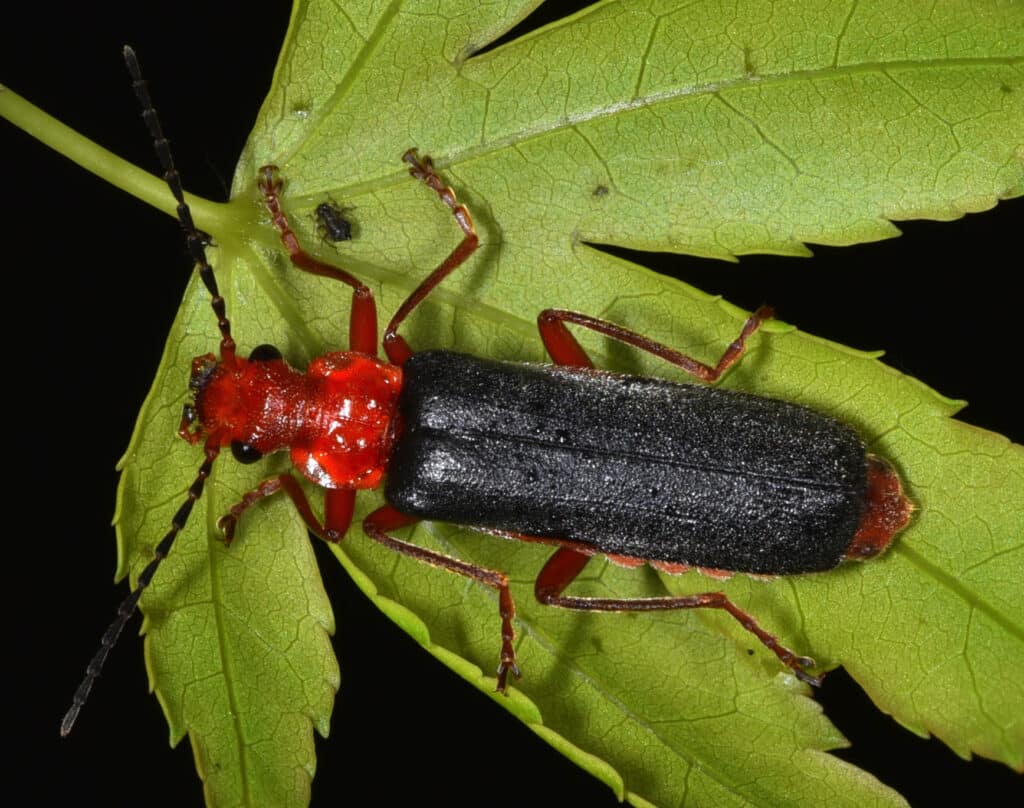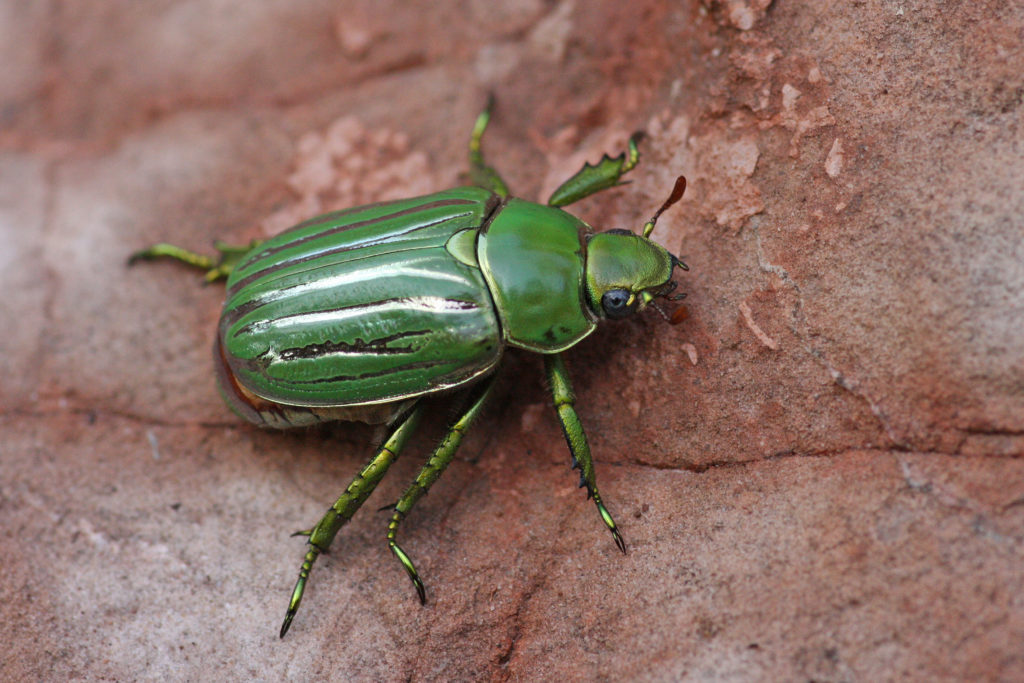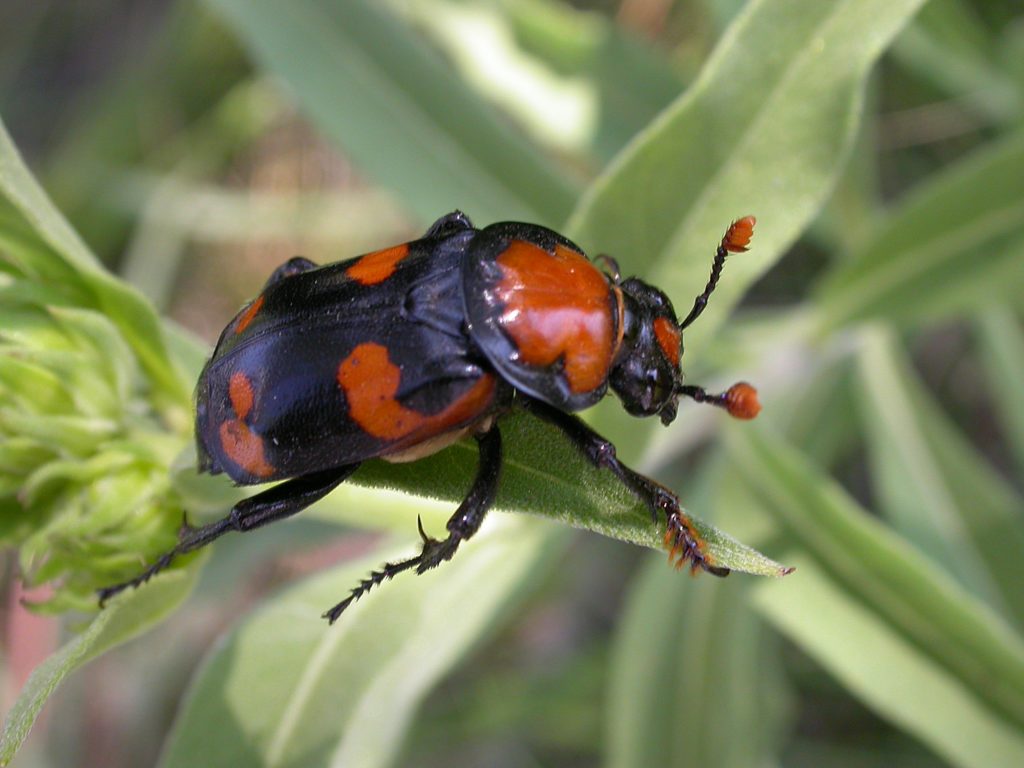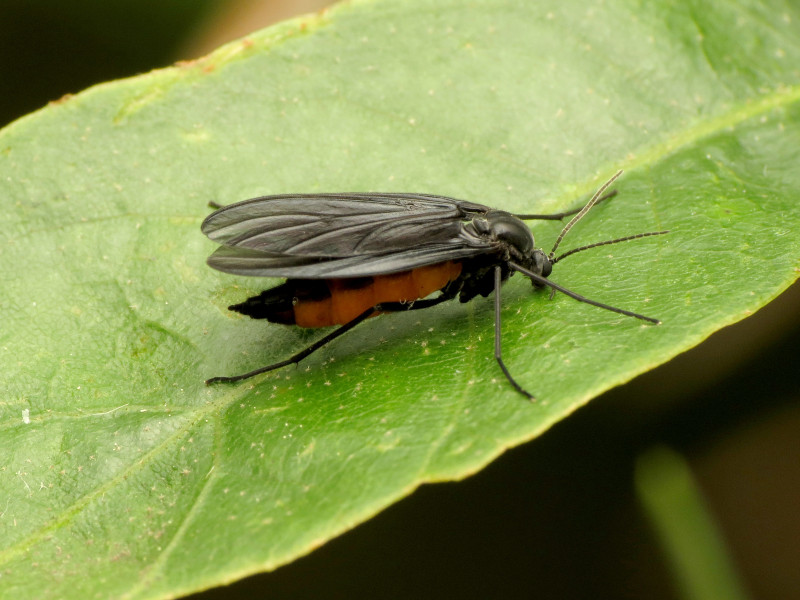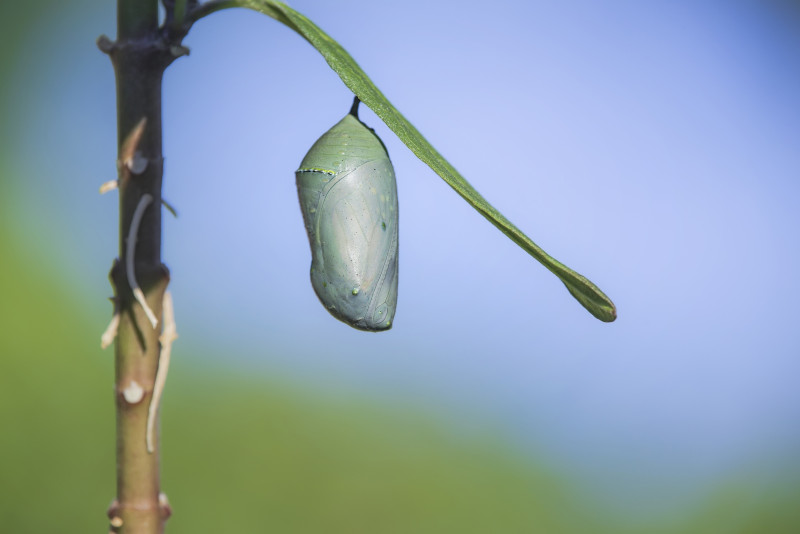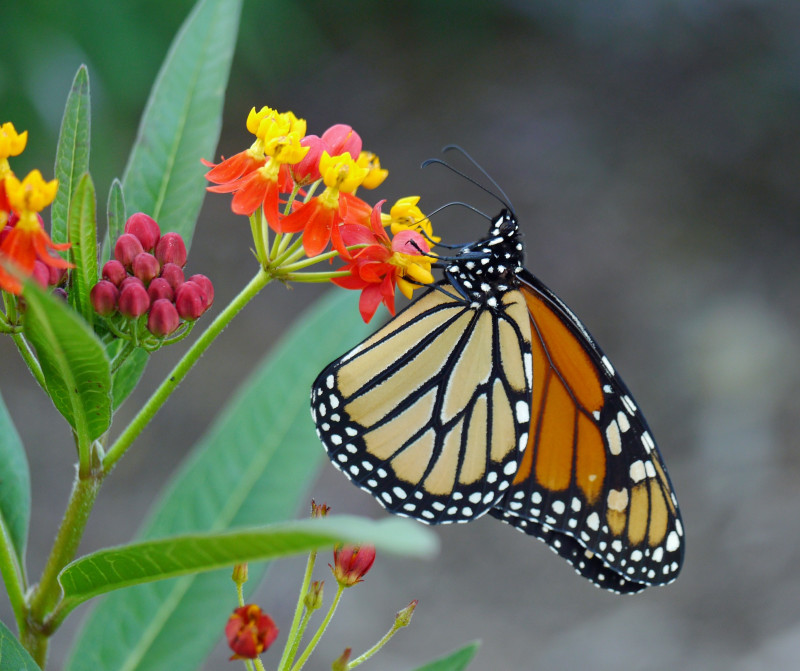One or more of these ladybugs and other beetles live in your yard. Look for them on foliage or flowers, and sometimes on the ground. (Ladybugs are also known as lady beetles and ladybird beetles.)
“An inordinate fondness for beetles”
That was population geneticist J.B.S. Haldane’s reply when asked what he had learned about the “Creator” from his studies. And, no wonder—Coleoptera, the order of beetles (and weevils, their cousins), is the most populous on earth: 30 percent of all insects, 30 percent of all other animals; 300,000 known species, with over 30,000 in North America. And that’s just a drop in the bucket: an estimated five to eight million are yet to be discovered!
Ashy Gray Lady Beetle, Olla v-nigrum
The Ashy Gray Lady Beetle has two strikingly different color variations. They’re in the same family as the familiar red-colored lady beetles but with a different look. They’re found across most of the U.S., mainly from March to September. Their larvae can eat up to 400 aphids in the two to three weeks before they pupate! Their species name, v-nigram, means “black v” in Latin.
Multicolored Asian Lady Beetle, Harmonia axyridis

The many color variations of the Multicolored Asian lady beetle, Harmonia axyridis (Entomart / Wiki; CC BY-SA 2.0)
It’s easy to see how the Multicolored Asian Lady Beetle got its name. All the beetles you see here are color variations of this one species. Native to eastern Asia, they were introduced into the U.S. to control aphids and scale insects. They prefer warm weather, so they’re among those most likely to congregate in houses over the winter. They often go unnoticed, or even ignored by insect-lovers, because they leave on their own in the spring. They’re harmless to humans, pets, and property. The worst they’ll do is give off a slightly unpleasant odor and may (painlessly) nip if mishandled.
If you find yourself playing host to too many, just vacuum them up (use a clean bag). Please don’t leave them in the bag; gently empty them outdoors (perhaps under leaf litter at the base of a tree). If you can’t find and seal their entry hole into your house, release them far enough away that they aren’t likely to return.
This beetle has a backstory: There were several failed attempts to introduce them here, starting back in 1916. A last effort in 1980 failed, too—or so it seemed, until 1988 when some were spotted near New Orleans. They’re now found in almost every state and Canada, wherever there’s suitable habitat.
Convergent Lady Beetle, Hippodamia convergens
Found in gardens across the U.S., Convergent Lady Beetles spend most of their time on plants, looking for aphids. But during hard times, they’ll eat nectar, pollen, other plant parts, melon, and honeydew. These beetles typically have twelve spots on their back, but not all do.
Polished Lady Beetle, Cycloneda munda
The first thing you might notice about the Polished Lady Beetle is its lack of spots. It’s one of only three U.S. species in the genus Cycloneda, all lacking spots. It’s also called the Red Lady Beetle and the Immaculate Ladybird Beetle. They’re found across the eastern two-thirds of the U.S., primarily from May to October.
Seven-spotted Lady Beetle, Coccinella septempunctata
These lady beetles are easy to identify: just count the spots on their “back” (really, it’s their folded forewings, technically called elytra). This beetle was unsuccessfully introduced into the U.S. from Europe several times between 1956 and 1971 to control aphids, but they kept dying out. Then, in 1973, a group was found in New Jersey, apparently due to an accidental introduction. Since then, they’ve spread throughout N.A. When these beetles are threatened, they sometimes play dead and emit a smelly substance.
They’re the principal pollinator of Magnolias. Magnolia blossoms don’t have nectar, but they do have lots of high-protein pollen, a favorite food of beetles.
“To catch an aphid, you’ve got to think like one.”1 That’s what NewScientist.com says regarding research results from the University of Colorado-Boulder. They’ve discovered that Seven-spotted Lady Beetles, ferocious predators of aphids, don’t go to plants that aphids aren’t likely to feed on. They go to plants likely to have them, often arriving ahead of the aphids.
Transverse Lady Beetle, Coccinella transversoguttata
This pretty beetle is found across most of the western U.S. Its numbers have declined since the introduction of and subsequent competition from the Seven-Spotted Lady Beetle and Multicolored Asian Lady Beetle. Like other lady beetles, look for it as it prowls for aphids.
Tortoise beetles, subfamily Cassidinae
Just look at that beautiful beetle! It’s one of about 3,000 species of tortoise beetles. Many of them sport brilliant colors but can be hard to spot because they’re tiny: 1/4–3/8 inches long (6.4–9.5 mm). They appear to be enclosed in a transparent tortoise-like shell, but it’s actually the unusually expanded width of their wings and thorax. The Golden Tortoise Beetle shown above is widespread in the U.S. Its beautiful gold color sometimes changes to red when startled. Look for them on the foliage of morning glories, sweet potatoes, and bindweed.
Fireflies/lightning bugs, family Lampyridae
Hot weather means it’s firefly time—one of the best things about summer. Also called lightning bugs, they’re beetles that inhabit the eastern half of the U.S. They like warm weather and moisture—ponds, streams, marshes, and rivers. Even a puddle holding water may suit them. There are about 2,000 species in the world. Most produce a flashing light in special organs on the underside of their abdomen. It’s an amazing process called bioluminescence. Each species has a unique pattern used to help them find mates of their own species. For unknown reasons, very few fireflies live in the western half of the U.S., not even where there’s water.
To spot adult fireflies in the daytime, look on foliage, tall grasses, or the ground. If you want to attract them, add water features to your yard, and don’t use pesticides and synthetic fertilizers. Plant tall grasses or allow an area of turf grass bordering trees to grow tall.
Soldier Beetles, family Cantharidae
Soldier beetles are common across the U.S. but more predominantly in the eastern half. Despite their name, they don’t go into battle but are harmless and beneficial as pollinators that eat nectar and pollen. Because of the coloration many of them have, they were named after the red coat of early British soldiers. They all have long bodies, making them pretty easy to identify. The species shown above inhabits the western U.S.
Glorious Scarab Beetle, Chrysina gloriosa
The Glorious Scarab Beetle is one of the prettiest beetles in the U.S. About 0.87–1.10 inches ( 22–28 mm) long, they inhabit the Southwest and feed on juniper plants. Look closely; their coloration makes them hard to spot within foliage.
Carrion Beetles, family Silphidae
Carrion beetles are beneficial as “decomposers” who dispose of and recycle bodies of small dead animals. They do this by digging dirt out from under a body until it becomes buried. They feed on the corpse and also lay eggs in it.
The American Burying Beetle, also called the Giant Carrion Beetle, was the first beetle placed on the USFWS endangered species list (1989). Large, powerful beetles about 1.5 inches (3.8 cm) long, they were once endemic across N.A. But loss of habitat and habitat degradation and alteration have reduced their historic range to a mere 10 percent of its original. One of the few beetles to exhibit parental care, both males and females take part in tending and feeding their larvae. The USFWS has captive breeding programs to reintroduce the beetles into the wild.
Ground Beetles, family Carabidae
Ground beetles are the most common group of beetles, with more than 40,000 species worldwide. Most are shiny black or metallic and can be up to an inch (2.5 cm) long. Although the large ones may look dangerous, all are harmless to humans. Insects, however, better keep a sharp lookout as most are carnivorous. They like to stay hidden in the daytime, so look for them under logs, rocks, leaves, and grasses. At night, they’re sometimes attracted to lights. Considered beneficial, they can be found across the U.S.
Dung Beetles, superfamily Scarabaeoidea
Yes, dung beetles eat dung and even have a preference for herbivore poo over that of omnivores. Despite how gag-inducing that may be, they and other feces-eating insects do important work—that of keeping land cleared of poo. They have an excellent sense of smell, can find fresh poo quickly, and make it disappear within hours. Many species roll excrement into a ball, moving over fifty times their body weight. They bury the balls either for eating later or brooding—the female will lay eggs in it. Some species guard their brood ball. Buried dung recycles nutrients into the soil. Some species include dog feces in their diet. Dung beetles are found everywhere except Antarctica and stay busy from spring to fall.
Their work is so important that some countries import them to benefit livestock—cleaning up dung removes habitat for flies and other pests. They’re said to save the U.S. cattle industry $380 million per year in the costs of burying livestock manure.
1 “Ladybirds think like an aphid to catch a meal,” NewScientist.com, April 3, 2012.


